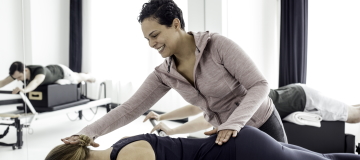
Are you struggling with persistent discomfort from a severe injury or chronic ailments, finding no relief in sight? Or perhaps you’re looking to regain strength and vitality? Have you ever considered Pilates? The integration of Pilates for rehab clients in their programs has proven highly effective. It complements physiotherapy seamlessly. Allow me to elaborate on why this is the case in this article.
Pilates for rehab clients
In recent times, Pilates for rehab clients has become more popular. Research indicates that Pilates, as a mainstream, low-impact exercise, can be effectively incorporated into your physiotherapy regimen. Studies have shown that Pilates yields significant relief for various types of pain and injuries, including:
- Chronic lower back pain
- Ankylosing spondylitis (Mrobus Bechterew)
- Multiple sclerosis
- Osteoporosis
- Non-structural scoliosis
- Hypertension
- Chronic neck pain
The core focus of Pilates
But why is Pilates so effective for physical injuries? This is because Pilates focuses on strengthening the core, or center, from which all movements originate. The core consists of the surrounding muscles of the spine. Strengthening and maintaining flexibility in these muscles are crucial for supporting and stabilizing the body. Pilates focuses on precisely this reinforcement.
Enhancing flexibility and mobility
Moreover, Pilates for rehab clients enhances flexibility and mobility for rehabilitation clients. Flexibility refers to the degree of passive stretching in a muscle, while mobility pertains to the range of motion of a joint. Pilates aims to strike a balance between flexibility and strength to optimize mobility. Pilates exercises are performed in a flowing manner, with controlled movements and smooth transitions, often at a deliberate pace. This controlled approach minimizes the risk of overdoing it.
Heightened body awareness
Pilates also fosters heightened body awareness. During a Pilates session, attention is paid to the alignment of the entire body, assessing the optimal range of motion of the joints and achieving balance among opposing muscle groups. This heightened awareness of posture contributes to pain relief by preventing the adoption of incorrect postures. By avoiding tensing up unnecessarily, you can experience freer movement despite your injury.
Breathing for more relaxation
Another often overlooked yet crucial aspect of Pilates is its focus on breathing. It serves as the fundamental principle. By concentrating on and breathing into the diaphragm, you activate not only the deep abdominal muscles but also promote relaxation, oxygen flow, and blood circulation. This results in an energy boost and reduces stress by regulating your nervous system through focused breathing. This emphasis on focus renders Pilates a low-impact training method, offering a reprieve from the daily grind. Lowering cortisol levels through Pilates can help alleviate stress in the long run. Given that injuries or chronic conditions often induce significant stress, Pilates for rehabilitation clients can provide much-needed breathing space, quite literally—a moment for you to truly unwind.
Are you currently undergoing rehabilitation or suffering from chronic physical ailments? Would you like to explore what Pilates can do for you? I’m here to answer all your questions, and together, we’ll tailor the best lesson plan for your rehabilitation journey.